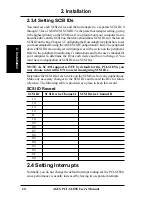
18
ASUS PCI-SC896 User’s Manual
2. Installation
2. Installation
2.2.5 Making External SCSI Bus Connections
This section provides step-by-step instructions about making external SCSI
bus connections:
1. If you need to connect external SCSI devices to the PCI-SC896 host
adapter, plug the 68-pin high-density connector on one end of a shielded
external high density cable into the host adapter connector J2.
2. Plug the 68-pin connector on the other end of the shielded external SCSI
cable into the SCSI connector on your external SCSI device.
3. If you need to connect more than one external SCSI device to your host
adapter, chain them together with shielded external SCSI cables.
2.3 SCSI Bus Termination
The devices that make up the SCSI bus are connected serially (chained together)
with SCSI cables. The first and last physical SCSI devices connected on the ends
of the SCSI bus must have a set of resistors called terminators. All other SCSI
devices on the bus must have their terminators removed or disabled.
REMEMBER: The PCI-SC896 host adapter is also on the SCSI bus,
and its termination is automatically enabled when it is connected to the
end of the bus.
Low-voltage differential peripheral devices are normally terminated with ex-
ternal terminators, but are sometimes set with jumpers or with a switch on the
peripheral. Refer to the peripheral manufacturer’s instructions and to the user’s
manual for your computer for information on how to identify the terminator
setting of each device and how to change it.
CAUTION: The auto-enable/disable sensing feature on the PCI-SC896
may enable termination erroneously if it is directly cabled to another
SCSI device or host adapter using the same sensing method. The PCI-
SC896 senses SCSI devices by detecting the ground signal on conduc-
tor 50 of a 68-conductor SCSI cable.
When connecting another host adapter to a connector, termination must be
disabled on the board that is not at the end of the bus through software control.






























